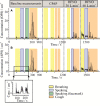Aerosol emission from the respiratory tract: an analysis of aerosol generation from oxygen delivery systems
- PMID: 34737195
- PMCID: PMC8867281
- DOI: 10.1136/thoraxjnl-2021-217577
Aerosol emission from the respiratory tract: an analysis of aerosol generation from oxygen delivery systems
Abstract
Introduction: continuous positive airway pressure (CPAP) and high-flow nasal oxygen (HFNO) provide enhanced oxygen delivery and respiratory support for patients with severe COVID-19. CPAP and HFNO are currently designated as aerosol-generating procedures despite limited high-quality experimental data. We aimed to characterise aerosol emission from HFNO and CPAP and compare with breathing, speaking and coughing.
Materials and methods: Healthy volunteers were recruited to breathe, speak and cough in ultra-clean, laminar flow theatres followed by using CPAP and HFNO. Aerosol emission was measured using two discrete methodologies, simultaneously. Hospitalised patients with COVID-19 had cough recorded using the same methodology on the infectious diseases ward.
Results: In healthy volunteers (n=25 subjects; 531 measures), CPAP (with exhalation port filter) produced less aerosol than breathing, speaking and coughing (even with large >50 L/min face mask leaks). Coughing was associated with the highest aerosol emissions of any recorded activity. HFNO was associated with aerosol emission, however, this was from the machine. Generated particles were small (<1 µm), passing from the machine through the patient and to the detector without coalescence with respiratory aerosol, thereby unlikely to carry viral particles. More aerosol was generated in cough from patients with COVID-19 (n=8) than volunteers.
Conclusions: In healthy volunteers, standard non-humidified CPAP is associated with less aerosol emission than breathing, speaking or coughing. Aerosol emission from the respiratory tract does not appear to be increased by HFNO. Although direct comparisons are complex, cough appears to be the main aerosol-generating risk out of all measured activities.
Keywords: infection control; non invasive ventilation; respiratory infection; viral infection.
© Author(s) (or their employer(s)) 2022. Re-use permitted under CC BY. Published by BMJ.
Conflict of interest statement
Competing interests: None declared.
Figures



Similar articles
-
Aerosol emission and exposure in non-invasive ventilation.Sci Rep. 2025 Apr 23;15(1):14058. doi: 10.1038/s41598-025-98751-0. Sci Rep. 2025. PMID: 40269191 Free PMC article.
-
SARS-CoV-2 environmental contamination from hospitalised patients with COVID-19 receiving aerosol-generating procedures.Thorax. 2022 Mar;77(3):259-267. doi: 10.1136/thoraxjnl-2021-218035. Epub 2021 Nov 4. Thorax. 2022. PMID: 34737194 Free PMC article.
-
Aerosol Generation from the Respiratory Tract with Various Modes of Oxygen Delivery.Am J Respir Crit Care Med. 2020 Oct 15;202(8):1115-1124. doi: 10.1164/rccm.202006-2309OC. Am J Respir Crit Care Med. 2020. PMID: 32822208 Free PMC article.
-
Generation of Aerosols by Noninvasive Respiratory Support Modalities: A Systematic Review and Meta-Analysis.JAMA Netw Open. 2023 Oct 2;6(10):e2337258. doi: 10.1001/jamanetworkopen.2023.37258. JAMA Netw Open. 2023. PMID: 37819660 Free PMC article.
-
Airborne transmission of severe acute respiratory syndrome coronavirus-2 to healthcare workers: a narrative review.Anaesthesia. 2020 Aug;75(8):1086-1095. doi: 10.1111/anae.15093. Epub 2020 May 8. Anaesthesia. 2020. PMID: 32311771 Free PMC article. Review.
Cited by
-
What were the historical reasons for the resistance to recognizing airborne transmission during the COVID-19 pandemic?Indoor Air. 2022 Aug;32(8):e13070. doi: 10.1111/ina.13070. Indoor Air. 2022. PMID: 36040283 Free PMC article. Review.
-
A quantitative evaluation of aerosol generation during cardiopulmonary resuscitation.Anaesthesia. 2024 Feb;79(2):156-167. doi: 10.1111/anae.16162. Epub 2023 Nov 3. Anaesthesia. 2024. PMID: 37921438 Free PMC article.
-
Size distribution and relationship of airborne SARS-CoV-2 RNA to indoor aerosol in hospital ward environments.Sci Rep. 2023 Mar 2;13(1):3566. doi: 10.1038/s41598-023-30702-z. Sci Rep. 2023. PMID: 36864124 Free PMC article.
-
Risk of Bacterial Exposure to the Anesthesiologist's Face During Intubation and Extubation.Infect Drug Resist. 2023 Apr 25;16:2433-2439. doi: 10.2147/IDR.S405537. eCollection 2023. Infect Drug Resist. 2023. PMID: 37138835 Free PMC article.
-
Superspreaders drive the largest outbreaks of hospital onset COVID-19 infections.Elife. 2021 Aug 24;10:e67308. doi: 10.7554/eLife.67308. Elife. 2021. PMID: 34425938 Free PMC article.
References
-
- Infection prevention and control during health care when novel coronavirus (nCoV) infection is suspected. Available: https://www.who.int/publications/i/item/10665-331495 [Accessed 1 Apr 2021].
-
- Public Health England . 6. COVID-19 infection prevention and control guidance: aerosol generating procedures, 2020. Available: https://www.gov.uk/government/publications/wuhan-novel-coronavirus-infec... [Accessed 1 Apr 2021].
Publication types
MeSH terms
Substances
Grants and funding
LinkOut - more resources
Full Text Sources
Medical
